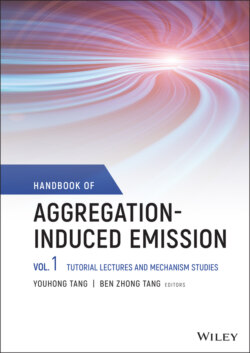Читать книгу Handbook of Aggregation-Induced Emission, Volume 1 - Группа авторов - Страница 32
2.2.2 Computational Details
ОглавлениеTo unravel the AIE mechanism, the photophysical properties of compounds in both the isolated (dilute solution) and the aggregated states (in amorphous aggregate and crystal) need to be considered. Different models were built according to the specific environment of the studied systems.
For the dispersed molecule in dilute solution, the polarizable continuum model (PCM) model is chosen to include bulk solvent effect implicitly (see Figure 2.1a). The polarities of different solvents are represented by dielectric constants.
In crystal, the hybrid quantum mechanics/molecular mechanics (QM/MM) model can be set up based on the experimental crystal structure to consider the environment effect. First, a large cluster is extracted from the crystal. To balance the accuracy and computational cost, the cluster is spatially divided into a region where the QM description is essential, with the remainder represented by MM classically (Figure 2.1b). The general Amber force field (GAFF) [27] or the united force field (UFF) was used for the MM treatment. In the QM part, density functional theory (DFT)/time‐dependent DFT (TDDFT) is chosen to deal with the properties of the ground and excited states, respectively. During the calculation, the QM molecule is active, and all molecules in the MM region are frozen. The electrostatic embedding scheme was adopted to consider the interactions between QM and MM regions [28, 29].
For AIEgens in amorphous aggregate, the molecular conformation is not available in the experiment. Therefore, the large time‐scale molecular dynamics (MD) simulations need to be performed in solution to obtain the conformations of amorphous aggregates of AIEgens. The topology of the AIEgens could be set up by GAFF. The initial conformations were generated by randomly placing tens or hundreds of AIEgens in cubic simulation boxes with enough edge length. Then, the randomly dispersed AIEgen system was solvated by specific solvents reported in the experiment. The energy minimization was firstly performed using the steepest descent algorithm, followed by a 5‐ns pre‐equilibrated MD simulation under the NPT ensemble. Finally, several long time‐scale (more than 20 ns) production MD simulations were performed with different initial velocities coupled by the velocity rescaling thermostat [30] and Parrinello–Rahman barostat [31]. The time step was 2 fs. The configurations were stored at a specific time interval (e.g. 20 ps) for data analysis and the following calculation of photophysical properties. Then, we randomly extracted equilibrated aggregates from MD trajectories and set up QM/MM models accordingly to calculate the optical properties. Different from crystal, the molecular packing of amorphous HPS aggregates is irregular, resulting in distinct local environments for each molecule in amorphous aggregate. For example, the molecule embedded in aggregate is much different from the exposed one. In addition, conformations of different frames or trajectories are also different. Thus, several MD conformations need to be extracted from MD trajectories to set up QM/MM models to consider various molecular packings in amorphous aggregate. In the QM/MM model, the solvents could be removed from the extracted MD conformations to reduce the computational cost. In each QM/MM model for amorphous aggregate, one molecule is chosen as the QM region, and the others are treated as the MM region (see Figure 2.1c). The other details of QM/MM calculations are similar to that in crystal.
Figure 2.1 (a) Setup of the PCM model for an isolated molecule in solution; setup of the QM/MM models for a molecule in (b) crystal and (c) amorphous aggregate. The molecule in green is the QM region and the others in silver are the MM region (taking HPS as an example).
The QM calculation in the PCM model can perform in Gaussian 09 [32], Turbomole 6.5 [33], NW‐Chem [34], and so on. QM/MM calculations could be carried out by the ONIOM model in Gaussian 16 [32] or through the ChemShell interface [35]. MD simulation can be done by the GROMACS package. The DRE, reorganization energy (λ), kr, and kic can be calculated by the MOMAP program [26, 36].
